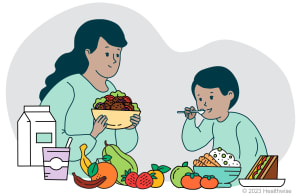Learning About How to Make Healthy Changes in Your Child's Diet
Maybe you've been thinking about changing your family's eating habits. Childhood is a great time to learn healthy eating habits. Healthy eating can help your child feel good and stay at a healthy weight. It can help your child have plenty of energy to learn and play.

Offer your child a variety of vegetables and fruits, whole grain foods, and protein foods.

Changing your child's eating habits can take time. That's common.
Children can learn more about healthy eating as they grow. Here are some ideas to help your child eat well.

Serve healthy foods and drinks.
- Offer lots of vegetables and fruits every day.
- Offer water when your child is thirsty.
- Keep healthy snacks that your child likes within easy reach.
- Try new foods together.

Prepare meals and snacks.
- Let your child help choose healthy foods. Your child can add items to the grocery list or help at the store.
- Cook meals with your child.

Teach your child about healthy eating.
- Eat with your child. Let them see you eat healthy foods.
- Try not to use food as a reward.
- Talk to your child about what kinds of foods help them stay healthy.
Follow-up care is a key part of your child's treatment and safety. Be sure to make and go to all appointments, and call your doctor or nurse advice line (811 in most provinces and territories) if your child is having problems. It's also a good idea to know your child's test results and keep a list of the medicines your child takes.
Where can you learn more?
Go to https://www.healthwise.net/patientEd
Enter Q952 in the search box to learn more about "Learning About How to Make Healthy Changes in Your Child's Diet".
Current as of: October 24, 2024
